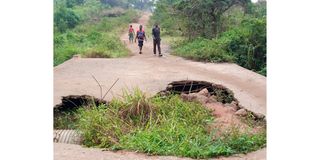Prime
Kole Bridge collapse cripples businesses

Pedestrians walk on the destroyed Agwar Bridge at the Kole-Oyam border on February 8. Its collapsed has crippled access to social services. PHOTO | BILL OKETCH
What you need to know:
- The problem has impacted the livelihoods of individuals who commute across the bridge for work, leading to job losses, reduced incomes, and financial hardships.
Since 2019, residents of Alito and Aleka sub-counties in Oyam and Kole districts have been struggling to access social services following the collapse of the Agwar Bridge.
The bridge at the Kole-Oyam border is five kilometres from Alito Sub-county headquarters.
Local leaders said for nearly six years now, pupils of Agoma Primary School, farmers, and traders have been facing problems with connectivity after the bridge collapsed due to the heavy rains in 2019.
Also, the problem has impacted the livelihoods of individuals who commute across the bridge for work, leading to job losses, reduced incomes, and financial hardships.
“Because of the collapse of the bridge, people from the Aleka side cannot access Anekapiri Market and pupils are finding difficulties accessing Agoma Primary School,” Mr Tom Olet, Alito LC3 chairman, told this newspaper in an interview on Tuesday.
He said the collapse is having huge impacts on local businesses and communities, adding that his administration is unable to repair the bridge because of a lack of funds.
“We receive Shs17.1m for road repair from the Uganda Road Fund and this money is not even enough for us to work on our community access roads. That bride alone needs more than Shs400 million for it to undergo major reconstruction,” he said.
In the absence of a functional bridge, alternative transportation options such as longer routes are being utilised.
However, these alternatives have become more expensive and time-consuming, adding to the transportation costs for businesses and individuals.
Mr Dicken Ocere, a teacher at Aleka Primary School, said increased transportation expenses can affect the profitability of businesses and may necessitate higher prices for goods and services.
Likewise, Ms Sarah Opio, a resident of Alito Sub-county, said: “We are using a long route to go to Lira Regional Referral Hospital, which is costly and time-consuming.”
Mr Bonney Okello, another resident, said: “Farmers are being cheated by middlemen because they cannot take their produce to Lira City. The collapsed bridge has blocked vehicles that should be transporting our goods.”
The collapse of the Agwar Bridge is having social implications as well, according to cultural leaders and social workers.
“Communities on both sides of the bridge are currently experiencing a sense of isolation or disconnectedness, leading to a loss of social and cultural interactions,” Mr Bonny Ayo Lomo, a leader of the Bakocol Clan, said .
He also said the bridge collapse has further crippled access to healthcare facilities, schools, and other essential services, affecting the overall well-being of the community.
The district chairman, Mr Moses Andrew Awany, told this newspaper that the road whose bridge has collapsed falls under the sub-county, further acknowledging that the road fund to the sub-county has dwindled.
“As a district, we have many district roads to be managed and even this quarter no allocation was given to any district of the Shs1 billion the road fund and we cannot do much where no funds are available,” he said.
Economic activity
Like the rest of northern Uganda, agriculture is the main economic activity in Oyam and Kole.
Farmers engage in mostly subsistence farming to feed their families and then sell their surplus to raise money to meet family needs such as health and education.
Social workers say for the community to exploit the potential of agriculture, they must be supported with a good road network to transport their goods to market.




